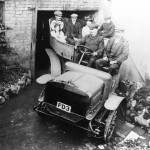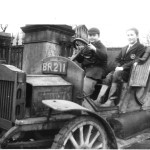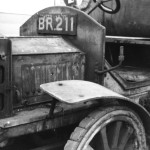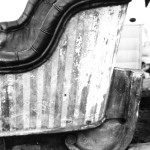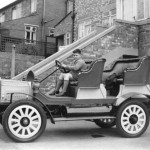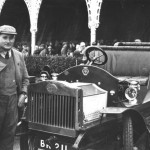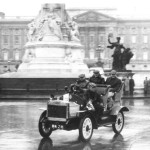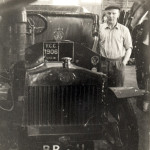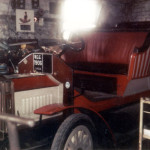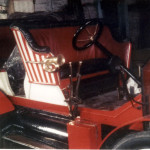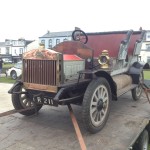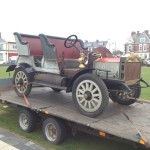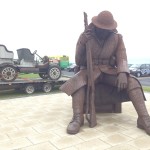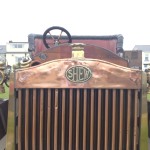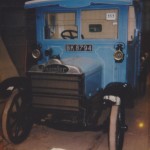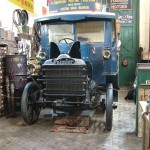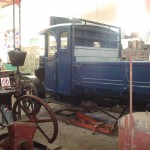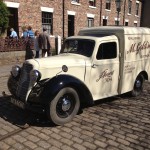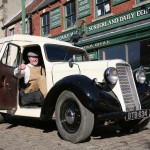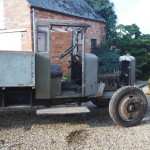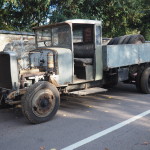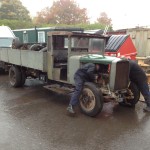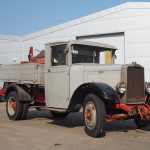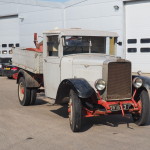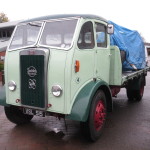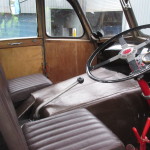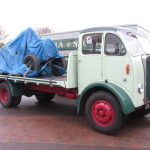
Welcome to the Commercial Vehicles page, detailing each vehicle in the collection along with a selection of photographs. Reference is made to more detailed articles where these appear under ‘Articles’ on this site. The vehicles appear in chronological order, with the ‘oddities’ at the end…
SHEW 1907 ‘Pick-up’
Registration: BR 211
Possibly one of the star attractions, certainly one that prompts most questions, in the Town Garage is the SHEW car – the name alone provoking comment and curiosity. When explained that SHEW stands for Seaham Harbour Engine Works, the questioner is probably little clearer on the subject matter, a small car with unusually flamboyant seats, a care worn appearance and very prominent radiator. However, this perhaps misses the point of a very important piece of local history, perhaps most significant as a ‘might have been’ rather than in its own sense of technological or social place in the collection.
In 1907 two articulated vehicles were manufactured at the Burnt Tree Engineering Works in Dudley, to a patent for ‘steering of motor cars’ submitted by Thomas Parker in 1897. The chassis was in two sections, pivoted in the middle and with a steering rack that created the turning action around the central pivot, much like modern dump trucks function.
Of the first two vehicles – one was fitted with a four cylinder White and Poppe petrol engine, the other (the SHEW) a two cylinder Forman engine. The front portion is self contained – the engine, gearbox and drive all being located here (note the drive chain inside the front wheel) and the rear section essentially a trailer. Great manoeuvrability was claimed and was presumably the purpose of this photograph! The SHEW is probably the second of the vehicles, the first being used as a taxicab in London for some months. As a result of this success the Sedan Auto-Car Syndicate was created to develop the idea.
The Sedan Auto-Car Syndicate purchased the Burnt Tree works in late 1907 and further developed the Parker chassis principle. The SHEW at Beamish is probably their second vehicle, perhaps started prior to their purchase of the works, but by now part of their output. They sought a production partner for the design and turned to the Seaham Harbour Engine Works (SHEW) who had established themselves with a reputation for construction both railway locomotives and steam lorries (known as Londonderry Waggons). After a change in personnel, the works was looking for alternatives to steam construction and made some speculative attempts to establish a motor vehicle range were therefore made. Enter the Sedan Auto-Car Syndicate who commissioned SHEW to produce motor vehicles to the Parker patents.
The Forman engine vehicle was dispatched to Seaham, arriving in 1908. Fitted with a 16HP engine and artillery wheels, its intent was probably as a commercial vehicle rather than passenger carrying one. Colour is thought to be green/black with white lining.
Three vehicles were manufactured at Seaham, one being photographed and supplied to the Coalite Company, another in van guise also being photographed by the contemporary motoring press. Of note for these was the radiator set up behind the engine (where the bulkhead would be fitted) – very similar in appearance to that now fitted to the front of the preserved SHEW – suggesting that this at least is a Seaham component.
SHEW used the vehicle as a works hack (deliveries and collections) whilst they evaluated it. It was found ‘wanting’ and so in 1910 the chassis was made ridged, conventional Ackermann steering was fitted, the drive was moved to the rear axle, the bonnet modified and a seat fitted that may originate from a horse drawn vehicle of the period. The 1906 registration was a Sunderland allocation and would have been required for the SHEW’s duties around Seaham (where it was involved in an accident with a bicycle, for which E. Saunders, the driver, was fined £5!).
With the demise of both the SHEW (works) and Sedan Auto-Car Company around 1912, after the production of only three more vehicles, the car was used until WW1 broke out in 1914, when it moved to Lord Londonderry’s estate at Wynyard Hall (sources differ on the date – some state the move was 1912). On the estate (Londonderry owned the controlling share in the Seaham Harbour Dock Company plus extensive coal and railway interests) the car (as we shall now refer to it) continued its general purpose role, complete with a tool chest on the rear platform. It was probably in store by the time of the outbreak of WW2.
In 1956 Fred Baxter, a Model T Ford collector from Harrogate, became aware of the SHEW in an outbuilding on the Londonderry estate at Wynyard Hall. He alerted George Kendrew from Stockton-On-Tees, who obtained the car and set about a rebuild to enable it to participate in the 1957 London to Brighton run – a challenge set and successfully met. In carrying out this work, Mr Kendrew carried out a number of modifications – the most noticeable of which included the cut down wheels (in order to take a Model T Ford rim and pneumatic tyre), replacement of the rear deck with a seat (reproduced from the front seat) and removal of some detail trimmings. The car was finished in a red and white colour scheme (though following the colour panels evident on the original coachwork) – Mr Kendrew apparently being a Sunderland FC fan!
Mr Kendrew claimed the origins of the car as 1904, but makers marks on the chassis (Rubery, Owen and Company) can only date from October 1905, the engine dates from 1906 and the BR 211 registration is also 1906. The wheel hubs have cast hubcaps, title ‘Sedan’ – the Sedan Auto-Car Syndicate as we saw earlier dates from 1907, so despite some dating to 1906, the origin of the car is much more likely to be 1907. Thus it was ineligible for the VCC run though this revision to the date is of little consequence to its importance to Beamish in terms of local history and appeal.
On July 4th 2015 the SHEW was taken to Seaham to take part in the classic car show there, this being the first time in the town for a century! This precipitated thoughts towards a ‘project’ around the vehicle.
For many years it has been left untouched as it was felt that the work to conserve/restore it was beyond the facilities the Museum had at the time. After the work on the Barford & Perkins motor roller R025, I now believe we are in a position to consider doing something with the SHEW and there is a keen volunteer team available along with the space and workshop facilities to support the work. And so we have the question of what guise to restore it to. These can be summarised thus:
- Completely restore the car to the condition it may have been in when built in 1907 including reinstatement of the Parker steering (much of this was retained when the Ackermann steering was fitted). The problem with this is that we don’t know with any certainty what it looked like!
- Restore it to the condition it might have operated at Seaham and later Wynyard in, as a single row of seats, platform rear body, Ackermann steering retained and solid tyres and original wheel diameter reinstated.
- Re-restore its restoration appearance per the 1957 work as an example of what was done in early preservation and as a feature on the Museum’s 1950s developments.
- Leave it completely alone and retain it on display in the manner in which it currently appears.
Taking the above on balance, the preference would be to overhaul the SHEW mechanically, reinstate the features evident in the 1956 photographs as these essentially reflect its appearance in the 1910s/20s, paint it in a subdued colour scheme and reflect the story of a motor car production that never was at Seaham as well as the vehicle’s life at Wynyard. This is least intrusive to the remaining fabric of the car, can follow photographic evidence of its condition and gives a very strong local story to interpret at the Museum. The aspiration would be that it be in full working order (and perhaps able to drive to Seaham under its own steam next time…), something that I am sure would be of great interest to visitors and enthusiasts alike. The work will involve substantial mechanical input from the volunteers, much curatorial head scratching from myself and others, some coachwork and reconstruction of the wheels to once again take solid tyres.
Daimler CK22 1923 Drop-side lorry (Museum ref: 1991-92)
Registration BK8794
Many visitors to the Museum will be familiar with this Daimler lorry, which for many years has resided in the Edwardian Garage and more latterly the Council Depot (from April 2015). It was built in 1923 by the Daimler Company Limited (Coventry), weighs 3 tons – 8 cwt – 44 lbs and was supplied to vehicle dealer J. H. Sparshatt of Portsmouth. It was sold by Sparshatts from their stand at the 1923 Olympia Exhibition (the bodywork being built by Sparshatts) to J Stride & Sons of Portsmouth who were market gardeners. In 1957 it was re-purchased by Jack Sparshatt, becoming one of the first preserved commercial transport vehicles in what was then a very embryonic heritage movement. The Sparshatt business had started with the reconditioning and sale of ex military equipment and this 3 ton lorry was of a design not a million miles away from the subsidy lorries produced by numerous manufacturers in WW1.
It was eventually offered for sale and was purchased for display at Beamish. It is believed to have been operated on one occasion, but the main intention was for it to be displayed in the then new garage exhibit, which it joined in 1991. In an effort to make its appearance more complimentary to the period represented in the garage, some changes were made to its appearance, the most noticeable being the replacement of the curved steel mudguards/front wings with plain wooden versions. A large acetylene lamp was also fitted and the livery changed. It was displayed for some time with the contents of a house clearance, which had been donated to the Museum, but which was removed after woodworm was discovered in some of the furniture, which unfortunately had also penetrated the Daimler’s timber bodywork. Original livery was light blue with pale lining (probably white).
The Daimler has a 2 – 3 ton carrying capacity and a wheelbase of 13′ 6″. A 4-speed crash gearbox is connected to the rear axle via a cone clutch and worm drive. The footbrake acts on the transmission whilst a handbrake acts on the rear wheels only. The engine is very interesting, being a Knight 4 cylinder sleeve valve petrol engine rated at 22.4hp. This was a design originating in the USA and was used by Daimler from 1908 through until 1933 (replacing more familiar poppet valve types). The distinctive Daimler badged alloy radiator dominates the bonnet, with the leaf springs projecting forwards to their mounting brackets on the front of the chassis rails.
The plan for this important vehicle is, in due course, to restore it to its original appearance in J Stride livery and with the correct front wings. Extensive work will also be required on the timber bodywork and also careful investigation of the chassis too (which is a timber/steel composite structure). One other CK survives, a 1921 flat bed variant on pneumatic tyres (probably fitted in 1928). It has a different cab arrangement but bodywork was simple and often would be manufactured by the agent/dealer or even customer or their favoured coachbuilder rather than the chassis manufacturer.
Model T Ford 1922 22cwt Van
Registration:
Model T Ford 1925 1 Ton Truck
Registration:
Austin 20 1928 Motor Hearse
Registration:
Commer 8cwt 1933 Van
Registration:
Leyland Cub 1934 KG3 Dropside Truck
Registration: VV 2708
At the end of October 2015 we collected a 1934 Leyland Cub KG3 lorry and the remains of a dismantled KP2 bus (also ex Crosville). The haul includes numerous spare parts as well, so it should prove possible to restore the lorry as well as substantially add to our stocks of spares (which includes a working and complete petrol engine – Leyland using Chrysler derived six cylinder side valve engines on the Cubs for many years). This particular Cub, seen below, was used for collecting animal remains for rendering/reprocessing/leather making until 1966, and features a coachbuilt cab by York, Ward & Rowlatt of Wellingborough (rather than a Leyland example). Within hours of arrival the Cub’s engine had been started, proving there may be life left in it yet! No immediate plans exist for its restoration, though this remains a medium-long term aspiration. Meanwhile, it is stored on site at Beamish.
Leyland Cub KG3 Tipper Lorry
Registration: BV 1673
This Leyland Cub was built in 1932, being first registered on the 30th July that year. It was new to Blackburn Corporation, finished in their dark green livery with black wings and chassis and gold lettering. Some of the lettering is still visible beneath the present grey paintwork. It was sold by Blackburn in 1965 to Harry Booth of Barnsley, West Yorkshire, who carried out a programme of restoration as well as repainting the tipper into a livery of Grey body and red chassis and wheels. In December 1996 the lorry was sold to David Akenhurst in Kent, who owned it until 2015. It passed through one more owner, briefly, after that.
It weighs 2 tons 17cwt unladen and is fitted with Leyland’s six-cylinder four litre petrol engine as developed for the Cub range in the early 1930s.
In 2016 it was purchased by Beamish Museum and some commissioning work was carried out by Historic Vehicle Restoration before it arrived at the Museum in April of that year. The tipping mechanism remains to be restored to working order and in time the lorry will be returned to its original appearance in Blackburn Corporation livery. Last taxed in 1997, it would seem this was the last time that it was used. The magneto has been overhauled, similarly the starter motor, and the electrics have been tidied up. The radiator from Beamish’s other KG3 lorry is temporarily fitted as that which was on the tipper had a bad leak. The cab seat was replaced with one of the correct pattern and new tyres were fitted all-round. Further work will be required, but the lorry is in working order and in use around the Museum on general haulage duties.
Morris Commercial 33cwt 1933 Flatbed Lorry
Registration:
Albion 1947 Furniture Removal Van
Registration: TBC
Seddon Mk5 1953 Flatbed Truck
Registration: VSL 515
This recent addition to the collection is a 1953 Seddon Mk5 fitted with a Perkins P6 diesel engine. We are its eighth owner, it having been restored in the early 2000s, but originally registered in Bradford in 1953. At some point its registration number TBB 18 was lost (presumed sold) but it was given an age-related registration of VSL 515 as a replacement. it is used daily by the Site Support team for work across the Museum, so once again has a ‘load on its back’ most days, albeit with rather lower mileages than it would have experienced during its commercial life. It is due to be repainted in 2016.
Fordson E83W ‘Thames’ Pick-up
Registration:
Bedford CA Ambulance
Registration:
Landrover Series 2A
Registration:
Lister Autotruck
Mercury Autotruck

